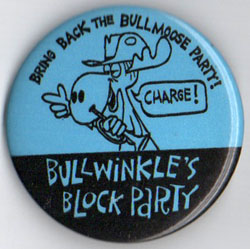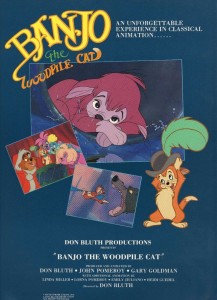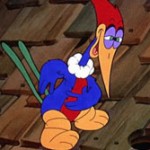 Jay Ward Hoopla! From the underground comix magazine STOP! #3 (1982) that was published in New York, here is an excerpt from an interview by Judy Wilmot of Bill Scott:
Jay Ward Hoopla! From the underground comix magazine STOP! #3 (1982) that was published in New York, here is an excerpt from an interview by Judy Wilmot of Bill Scott:
“When we opened the (Jay Ward) Studio, we put a great big statue of Rocky and Bullwinkle up in front of the building and we closed Sunset Boulevard. The way we could do this, is Sunset Blvd. is a strip in the county and the Sheriff is in charge. We asked him to be guest of honor. He was hesitant about it until we got Jayne Mansfield as a guest of honor too. And so he was happy. Sheriff Peter Pitchess. And there was a terrible traffic jam, cause Sunset Blvd. is one of the busiest streets in the world. We put up this big sign saying ‘Watch the Bullwinkle Show or We’ll Close the Other Half’.

“Jay (Ward) was always thinking of ways to promote the show. We had a picnic at the Plaza in a posh ballroom, full of gingham table cloths, hot dogs, fried chicken, beer. And we put in huge ant farms all around the room. We brought our own ants. That was a success. Some weren’t. Like the Coney Island Film Festival. We had a party and it went all right but then we took a special chartered subway out to Coney Island and unfortunately it rained. One of the heaviest rains reported in New York in twenty years.
“And the statehood of Moosylvania campaign. We bought an honest-to-goodness island. In the swampy area between Canada and the United States. Nobody know where it belongs, around Minnesota. Jay traveled around in a tour van, with a band organ getting people to sign a petition. He tried to crash through the gates of the White House during the Cuban Missile Crisis. He’s lucky to be alive. Trying to crash the White House in an orange Chevy van with a moose on the front.”
There was even a record entitled “A Salute to Moosylvania: Recorded Live at the Moosylvania Jazz Festival” and you can hear it at this link. It was cut the size of a 45 rpm record, but plays at 33 1/3 rpm and features the “Moosylvania Anthem” and “The University of Moosylvania Fight Song”
 Bluth Leaving Disney. In the Minneapolis Star Tribune of July 16, 1982, animator Gary Goldman who was promoting the release of The Secret of NIMH (1982) stated, “We left Dsiney because we had become so frustrated because we’d been given the responsibility of putting films together but no authority. We had people below us who did not want to take direction from us and people upstairs who were listening both to us and to the little tots who were running upstairs wailing.
Bluth Leaving Disney. In the Minneapolis Star Tribune of July 16, 1982, animator Gary Goldman who was promoting the release of The Secret of NIMH (1982) stated, “We left Dsiney because we had become so frustrated because we’d been given the responsibility of putting films together but no authority. We had people below us who did not want to take direction from us and people upstairs who were listening both to us and to the little tots who were running upstairs wailing.
“(Our studio has animators who are) all green, very young and aggressive. They want to be the best. Now that the film’s over, everyone’s quite proud of it. We brought it in almost two months before the deadline and right on budget – $6.3 million which is half what The Fox and the Hound (1981) cost.
“The reason we made Banjo the Woodpile Cat was to make ourselves better for our jobs at Disney. When you go into the Disney training program, you don’t ever have questions. But once you’ve got a problem, then you have a question. So we did the picture just to bring up problems and then solve the problems.
“We’re slave drivers, but we’re usually paying most people more than we’re paying ourselves. That’s one problem we didn’t lick by leaving Disney: We’re still not getting much money. But if the picture does well, we’ll be collecting residuals after a few years, which is great, because I myself am not looking forward to eating dog food on a fixed income when I’m 68.”
 Lantz on Gags. From Video Review March 1983, Walter Lantz stated: “Another thing I learned from cartoon production is building on a joke or working up a ‘running gag’. This is nothing new, of course. Virtually every classic comedy uses a running gag as a vehicle for audience involvement and big laughs. Don’t be afraid of a gag not working. The worst thing that can happen is a veil of silence falling over the audience. In my case, though, if I had showed an unfunny scene, I would have been fired.”
Lantz on Gags. From Video Review March 1983, Walter Lantz stated: “Another thing I learned from cartoon production is building on a joke or working up a ‘running gag’. This is nothing new, of course. Virtually every classic comedy uses a running gag as a vehicle for audience involvement and big laughs. Don’t be afraid of a gag not working. The worst thing that can happen is a veil of silence falling over the audience. In my case, though, if I had showed an unfunny scene, I would have been fired.”
Bobe Cannon. Paul Etcheverry did an extensive interview with Bill Scott on his lengthy animation career on November 24, 1981. Here is an excerpt about Bobe Cannon:

A scene from Bobe Cannon’s BALLET-OOP (1954)
“Two major things pretty much ruled what Bobe was going to do. First, he loved ballet, was crazy about ballet. He considered animated movement a form of ballet and when he would design a film, it would largely be in terms of ballet motion. I don’t mean necessarily classic ballet, but certainly as far as choreographed motion. In his own mind, every film must be choreographed.
“Second was that Bobe could not stand conflict. He did not like loud things. He did not like argument. He himself was a very repressed man, as far as expressing himself was concerned. He did not consider himself to be particularly bright, intelligent or able to explain himself. As a consequence, Bobe’s rages were something to behold because by the time he blew up at something or somebody, he would have repressed so much anger and hostitlity down inside him that something trivial would set him off into a rage where he would throw things around and storm out of the studio.”
Another American Tale. In the May 3, 1990 issue of the U.K. newspaper the Daily Express, the article stated that Steven Spielberg was looking for a team of British animators to work on his next film, An American Tail II. “Spielberg is entertaining animators in a whirlwind round of cocktail parties and offering huge fees for signing up with him. He has told friends that the film will eclipse all his previous massive successes.”
An American Tail: Fievel Goes West was released in 1991. It was the first production for Spielberg’s Amblimation animation studio (with Fievel the mouse as its mascot) whose offices were located in Acton, London. Monty Python’s John Cleese turned down the role of Cogsworth the clock in Disney’s Beauty and the Beast to play Cat R. Waul in this film.


 Jim Korkis is an internationally respected animation historian who in recent years has devoted his attention to the many worlds of Disney. He was a columnist for a variety of animation magazines. With his former writing partner, John Cawley, he authored several animation related books including The Encyclopedia of Cartoon Superstars, How to Create Animation, Cartoon Confidential and Get Animated’s Animation Art Buyer’s Guide. He taught animation classes at the Disney Institute in Florida as well as instructing classes on acting and animation history for Disney Feature Animation: Florida.
Jim Korkis is an internationally respected animation historian who in recent years has devoted his attention to the many worlds of Disney. He was a columnist for a variety of animation magazines. With his former writing partner, John Cawley, he authored several animation related books including The Encyclopedia of Cartoon Superstars, How to Create Animation, Cartoon Confidential and Get Animated’s Animation Art Buyer’s Guide. He taught animation classes at the Disney Institute in Florida as well as instructing classes on acting and animation history for Disney Feature Animation: Florida.




















































An American Tail: Fievel Goes West spawned a very short lived tv Series on CBS in 1992 called Fievel’s American Tails (which was based on An American Tail:Fievel Goes West) as well as the Reading Buddies sponsered by RIF. I don’t know why “F.A.T” didn’t fare so well and was canceled after one season and by the time the series was canceled An American Tail came out and Fievel and his family returned home to Manhattan,New York.
I think An American Tail: Fievel Goes West is a really good animated sequel. I’ve always admired almost all the films Steven Spielberg’s produced or directed, including this one. I think they did a really good job with this one.
I’d heard of Jay Ward’s pranks before, but not at this kind of detail. Hey, I still enjoy ROCKY AND HIS FRIENDS and THE BULLWINKLE SHOW (as ROCKY AND BULLWINKLE), and I stiill laugh at some of those jokes. The difference between Ward and Hanna-Barbera is that, when a corny pun came out, Ward’s people knew it was a painfully corny gag and treated it like that with noises or whatever, especially in the MR. PEABODY’S IMPROBABLE HISTORY segments…and the stuff never lost steam as the series progressed! Season four has some of the best FRACTURED FAIRY TALES of the entire series.
I’m guessing Allan Burns did the artwork on that Moosylvania record.